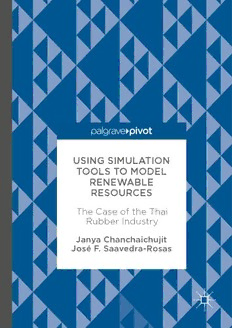Table Of ContentUSING SIMULATION
TOOLS TO MODEL
RENEWABLE
RESOURCES
The Case of the Thai
Rubber Industry
Janya Chanchaichujit
José F. Saavedra-Rosas
Using Simulation Tools to Model Renewable
Resources
Janya Chanchaichujit
é
Jos F. Saavedra-Rosas
Using Simulation
Tools to Model
Renewable Resources
The Case of the Thai Rubber Industry
Janya Chanchaichujit JoséF. Saavedra-Rosas
SchoolofManagement University ofChile
Walailak University Santiago
NakhonSiThammarat Chile
Thailand
ISBN978-3-319-55815-8 ISBN978-3-319-55816-5 (eBook)
DOI10.1007/978-3-319-55816-5
LibraryofCongressControlNumber:2017936921
©TheEditor(s)(ifapplicable)andTheAuthor(s)2018
Thisworkissubjecttocopyright.AllrightsaresolelyandexclusivelylicensedbythePublisher,whether
thewholeorpartofthematerialisconcerned,specificallytherightsoftranslation,reprinting,reuseof
illustrations, recitation, broadcasting, reproduction on microfilms or in any other physical way, and
transmissionorinformationstorageandretrieval,electronicadaptation,computersoftware,orbysimilar
ordissimilarmethodologynowknownorhereafterdeveloped.
Theuseofgeneraldescriptivenames,registerednames,trademarks,servicemarks,etc.inthispublication
doesnotimply,evenintheabsenceofaspecificstatement,thatsuchnamesareexemptfromtherelevant
protectivelawsandregulationsandthereforefreeforgeneraluse.
Thepublisher,theauthorsand theeditorsaresafe toassumethattheadvice andinformationinthis
book are believed to be true and accurate at the date of publication. Neither the publisher nor the
authorsortheeditorsgiveawarranty,expressorimplied,withrespecttothematerialcontainedhereinor
for any errors or omissions that may have been made. The publisher remains neutral with regard to
jurisdictionalclaimsinpublishedmapsandinstitutionalaffiliations.
Coverillustration:©HarveyLoake
Printedonacid-freepaper
ThisPalgraveMacmillanimprintispublishedbySpringerNature
TheregisteredcompanyisSpringerInternationalPublishingAG
Theregisteredcompanyaddressis:Gewerbestrasse11,6330Cham,Switzerland
To my mother, Armui Chanchaichujit, and in memory of my
dear father, AnuwatChanchaichujit, who told meto believe in
the power of my dreams and never surrender. Thank you to my
wonderful parents. Their faith in me and my capabilities
motivates me all the time.
Janya Chanchaichujit
To Paulina and Manuel, my
trusted and much loved partners in
this wonderful adventure
called life…
José F. Saavedra-Rosas
Preface
This book is about the application of simulation tools for the modelling
of renewable resources in the Thai rubber industry. It aims to provide a
hands-on approach to supply chain modelling by exploring the process
and decisions in building a model. The emphasis is on the Thai rubber
industry, modelled with the use of an open source software tool,
Ptolemy II.
The contributions of this book are twofold with regard to modelling
levels: how to model discrete event simulation (DES) using Ptolemy II,
fi
andhowThairubberproduction,atanindustriallevel,maybene tfrom
using this model for decision support systems. In addition, the simula-
tionmodeldevelopedinthebookismadeaccessibletothenon-technical
–
reader the manager, the entrepreneur or the policymaker in the Thai
—
rubber industry who can replicate it by following the instructions
fi
providedandbymakinguseofopensourcesoftwaretools.Thebene tof
using open source tools is that the reader is not required to make a large
investment (apart from their own time) in order to implement and use
the modelsdeveloped in the book. Techniques similar to those described
in the book may be used not only for rubber-related problems, but also
for any general application in renewable resources management,
vii
viii Preface
including the palm oil industry, forestry, farming and livestock
management.
This book consists of six chapters. Chapter 1 presents the background
relatedtothebook:thenaturalrubberindustry,decisionsupportsystems
fortherubberindustryandasimulationmodel.InChap.2,theelements
of the natural rubber industry supply chain are presented. This chapter
aimstointroducethereadertothephysicaltransformationofrubberand
fi
categories of natural rubber products. The common de nitions for each
rubbersupplychainentityandtheirrelevantprocessesarepresented,along
with logistics and marketing activities and decision making. In addition,
supplyanddemandmechanismsarediscussedinordertounderstandhow
priceisformulatedinthenaturalrubberindustry.Chapter3isconcerned
withthediscreteeventsimulation(DES)paradigm.Themainobjectiveof
thischapteristoprovidethereadersomebasicphilosophicalfoundations
ofthetechnique,anditalsoservesasabriefintroductiontoPtolemyII,as
it illustrates some of the concepts presented by using the software in the
contextofasimpleexample.Chapter4presentsadiscreteeventsimulation
(DES) model, which is built step by step using Ptolemy II, and the ele-
ments of the model are explained. After the design decisions have been
made,theelementsareimplementedandintegratedintothemodelbeing
built. In each step of the process, checks and control measures are put in
placeinordertoguaranteethevalidityofthemodelinawaythatresembles
unittestinginprogramming.InChap.5,thebuildingblocksdevelopedin
Chap. 4 are used to model the Southern Thailand rubber supply chain.
After the model is built, it is validated to check the consistency of the
observedmovementandthematerialmovementattheregionallevel.The
chapter concludes by analysing the capability of the model using case
studies. Chapter 6 concludes the book, with summaries and recommen-
dations for future research.
The authors would like to express their sincere gratitude to their
respectiveworkplacesforthesupportprovidedtothemduringtheirwork
on the book. Major support came from the School of Management at
Walailak University, Thailand; the School of Information Systems at
Curtin University; the Mining Department at the Faculty of
Mathematical and Physical Sciences, University of Chile; and Optika
Solutions, Perth, Western Australia. Special appreciation is expressed to
Preface ix
Thai rubber entrepreneur, Mr. Anan Pruksanusak, for his generous
support and time in our consultations on the Thai rubber industry.
Finally, the authors wish to express special thanks to their families,
who supported them wholeheartedly during the preparation and writing
of this book.
Nakhon Si Thammarat, Thailand Janya Chanchaichujit
Santiago, Chile José F. Saavedra-Rosas
December 2016
Contents
1 Introduction
1
2 The Elements of the Natural Rubber Industry
Supply Chain
19
3 Discrete Event Simulation Concepts
41
4 A Hands-On Development of a Discrete Event
Simulation Model for the Thai Rubber Industry
65
5 Model Implementation and Validation
97
6 Conclusions and Future Research Avenues
133
Appendix A: Farmer Size Distributions
139
Index
155
xi
List of Figures
Fig. 2.1 Categories of natural rubber products 21
Fig. 2.2 Natural rubber supply chain framework 22
Fig. 2.3 Rubber tapping 25
Fig. 2.4 Field latex production process 27
Fig. 2.5 Cup-lump production process 28
Fig. 2.6 Unsmoked sheet production process 29
Fig. 2.7 Primary rubber production process 29
Fig. 2.8 Small trucks for transporting primary rubber products
to traders 30
Fig. 2.9 Diagram of the ripped-smoked sheet production process 33
Fig. 2.10 Diagram of the block rubber production process 34
Fig. 2.11 Diagram of the latex concentrate production process 34
Fig. 2.12 Supply-demand mechanism framework of the natural
rubber industry 37
Fig. 3.1 System models taxonomy; in grey, the figure presents
the box that contains discrete event simulation. Adapted
by the authors from (Lawrence and Stephen 2006) 44
Fig. 3.2 Vergil welcome screen 51
Fig. 3.3 Selection of a new graph editor within Vergil 51
Fig. 3.4 An empty graph editor in Vergil 52
xiii

